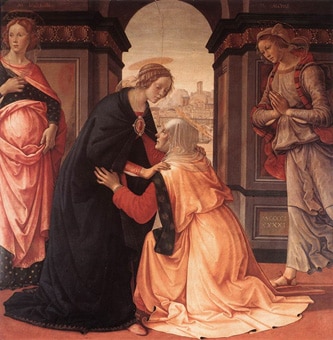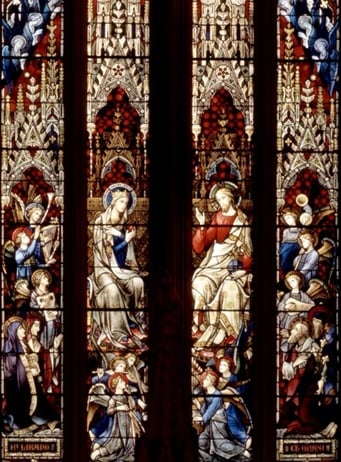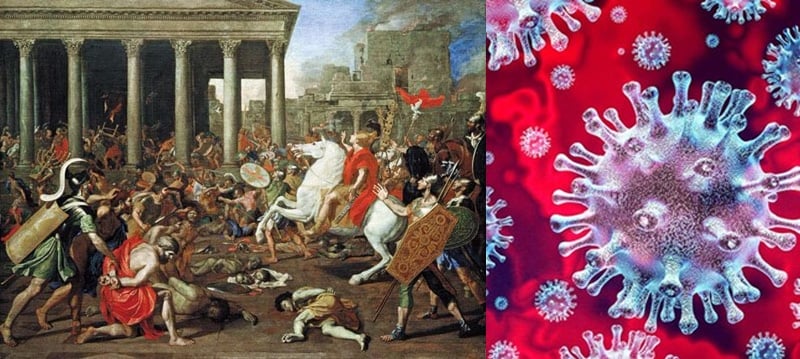HOMILY FOR END-OF-YEAR CAS STAFF MASS

St. Mary’s Cathedral, Tuesday 4th week of Advent
The Magnificat is the Church’s sunset song, recited or chanted tens of thousands of times round the world every day at Vespers. It comes, as we heard, from Luke’s Gospel (Lk 1:46-56), which is the Church’s first hymnal, including not only the Magnificat but also the Ave Maria, Benedictus, Gloria and Nunc Dimitis. It’s been set to glorious music by Monteverdi, Vivaldi, Bach, Mozart, Bruckner, MacMillan, so many great composers.[1] But what was it all about when Mary, full of the Holy Spirit, first sang it for cousin Elizabeth – with Zechariah and Joseph eavesdropping, if our Magnificat Window here at St Mary’s is to be believed?
Well, the first word that gives this canticle its name Magnificat gives it away: the Latin word we just heard translated as “proclaims the greatness” means literally enlarges or magnifies. John the Baptist introduced himself as one who must decrease so Jesus might increase (Jn 3:30): here Mary assumes the same posture. Despite being told by an angel that she’s Full of Grace, by a cousin that she’s Queen Mother and by all generations that she is ‘Blessed’, still Mary insists the focus must be on God.
When the ancients used the word magnificare they meant more than just esteeming someone. The Roman playwright Plautus, for instance, used it to encompass the kind of esteem that overflows in public acts of honouring.[2] In St. Jerome’s Latin translation which was received as the Western canon, he used the word to convey Mary’s outburst today.
It is in this active sense that Mary ‘magnifies’ the Lord – like a magnifying glass that doesn’t just report but selects, enlarges, sharpens, reveals things we might otherwise miss. Mary’s soul becomes a kind of hand-lens making God closer and clearer. In her song she recognises ways God has made His presence felt. He has long demonstrated His power, she says, by demoting the proud and promoting the humble, by sating the hungry and dismissing the satisfied, above all by protecting His darling Israel. The Great One has done great things.

Mary’s tweak to Hannah’s hymn is to focus not just on God’s power demonstrated in the past or hoped for in the future, but presently experienced as mercy. The unique thing that God is doing in her and that she’ll spend forever pondering is that the All-mighty has made Himself all-vulnerable, the Great One so little, so He can ally Himself with “his servant in her lowliness”, so He can “remember the mercy promised to our forefathers”, not by demonstrations of strength so much as in examples of God’s power working in the humble and through weakness. Of all God’s qualities, this unexpected power-become-mercy is what gets repeat attention in Mary’s triumphal song.
It’s no accident that the great magnifying glass of salvation history is not a potentate like Abraham or David, but that most powerless of people in the ancient world: a poor, young woman. Only in her ordinariness can she become Mother of all the living. The First Eve’s pride, her desire to magnify herself, is wiped away by the Second Eve’s humility, her desire to magnify the Lord. We see this in the Great Northern Window of this Cathedral, as Mary hands back the apple to Christ. And so we Mother of Mercy this vessel for Might-made-Mercy.[3] Praying the Hail Mary, we identify ourselves with sinners and the dying, for from Mary we learn a humility that allows the Word to take flesh in us, in our lives.

The pandemic has been a trial of faith and hope. For some God has seemed absent, distant, slow. Yet it’s precisely at such desperate moments that faith can spring back to life. Only when we realise we can’t get through on our own do we find ourselves leaning on something – Someone – greater.
The same has been true for the Church many times before. Whether at the height of persecution in the Roman empire or in the depths of ecclesial corruption at the turn of the first millennium; in the face of disastrous splintering at the Reformation or following the rise of ‘Enlightenment’ thought and Napoleonic anti-clericalism in the early 1800s; under the thumb of totalitarian regimes in the 20th century or amidst the challenges so far in the 21st, God’s death certificate has been issued many times and the Catholic Church’s with it. Yet on each occasion a spectacular turn-around has been just around the corner, as new saints, communities, spiritualities and evangelical energies emerged, as if from nowhere. The Saviour saves the poor mite that is the Church. In the meantime, a good pruning proved to be exactly what the Lord’s vineyard needed.
In Australia, Mass has been prohibited five times since 1788.[4] Each time the hunger of the faithful grew, the Church bounced back after the crisis, and practising rates went up. It’s too early to tell what effect COVID has had on Australians. But unaccustomed anxiety has led some to ask about the purpose of life and what’s most important to them, and this may have been a turning point…

The pregnant Mary emerges from a world of fear and anxiety, darkness and death, yet demonstrates a confidence that these are not the last word. She is pregnant with a Light the darkness cannot overcome, a Life even Death will not snuff out, a Love that conquers all. This year has been hard for many of you, I know. Not only have your own lives been turned upside down but, as servants of the Church, you have been conscripted to duty as ‘mini-Marys’. Each of you, in your leadership and service, has been an echo of Mary’s YES and a magnifying glass enlarging people’s sense of God’s presence, goodness, mercy. Your every good thought, word or deed, however mundane, magnifies the Lord. And when you persevere in doing good, even when your spirit does not felt like rejoicing, is a great tribute to you.
On behalf of the Church in Sydney, and all those whom she has touched through your efforts, I say thank you – from the bottom of my heart. God bless you and your loved ones and keep you safe in the new year ahead. Merry Christmas to you all!
WORD OF THANKS AND CAS SERVICE AWARDS AT END-OF-YEAR CAS STAFF MASS
St. Mary’s Cathedral, Tuesday 4th week of Advent
Dear friends, It’s been a joy to celebrate Mass with you and we thank God that that was still possible. I repeat my earlier words of thanks to you all for a great year’s work in extraordinary circumstances. I’m sorry that COVID restrictions have prevented my hosting you for a meal at my place this year: hopefully by next Christmas things will be back to normal. Perhaps we’ll be able to celebrate ‘Christmas in July’ as some like to do. I hope you enjoy your smaller-scaled functions in your various departments: I would have liked to join them all, but my GP is worried about my waist-size! I pray that this Christmas will be a time of blessing for you and your loved ones and 2021 a new year of grace.
We now come to our service awards for Archdiocesan staff. I invite Mr Michael Digges, our Executive Director (Administration and Finance), to announce these awards.
INTRODUCTION TO END-OF-YEAR CAS STAFF MASS
St. Mary’s Cathedral, Sydney, Tuesday 4th week of Advent
Welcome to our end-of-year Mass for the staff of the Catholic Archdiocese of Sydney. How very sad that we are back to sitting at opposite ends of the pews from each other in masks and unable even to sing an Advent carol! The latest outbreak and restrictions have capped off the strangest and most challenging year of our lives. Now we can anticipate a Christmas in which families and parishes cannot gather in their normal places and numbers. Yet through thick and thin you have persevered in your work of building people up as disciples, in strengthening our Eucharistic communities, in leading our agencies and ministries, or in doing the behind the scenes work that enables all that. In times like these, where people need reasons to hope, your work is more important than ever. I count myself very blessed to have yourselves as my colleagues in these strange times and I joyfully offer this Mass for your intentions.
To prepare ourselves to receive the Christ-child into the crib of our hearts at Christmas, let us repent of our sins…
[1] Monteverdi (1610), Charpentier (at least 10 versions, 1670s onwards), Vivaldi (1715, 1730, 1739), Bach (several from 1723 onwards), Mozart (several from 1779 onwards), Bruckner (1852), Rachmaninoff (1915), Rutter (1990), MacMillan (1999, 2001 etc.).
[2] Cf. Plautus, Stich., 1, 2, 4; Ps, 3,1 34.
[3] Cf. John Paul II, Dives in Misericordia, 9.
[4] From colonisation in 1788 until 1803 when Governor King briefly allowed the Mass to be celebrated by a convict priest in Sydney, Parramatta and Penrith; from 1804 until Governor Macquarie briefly overlooked Fr Jeremiah O’Flynn’s unauthorised chaplaincy in 1818; from then until 1820 when official chaplains finally arrived; in 1919 during the Spanish ‘flu pandemic; and in 2020 due to the COVID-19 pandemic.

